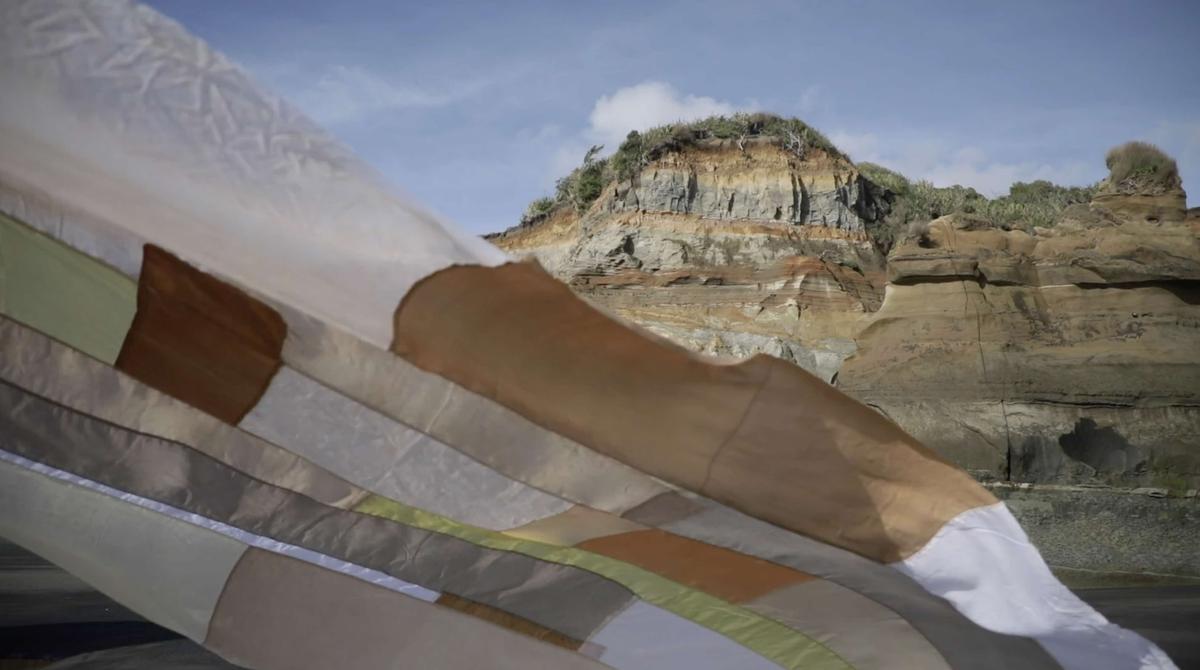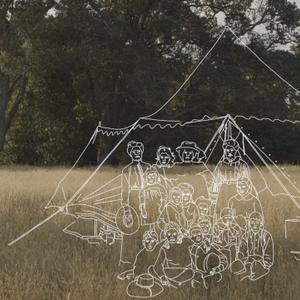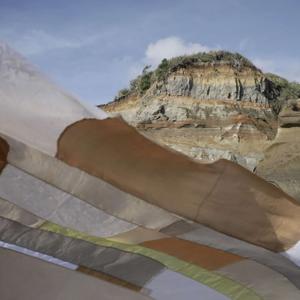Thomasin Sleigh: Today I thought we could talk about your three of your collaborative works we are sharing on CIRCUIT, Whatuora, Whatu Ahu Rua, and tōu tauira me tōu kaiako hoki. How did you two come to work together on these works?
Emily Parr: We first met when we started our Masters of Visual Arts at AUT, in 2019. There were only five of us in the program, so we just became really good friends quite early on. And very quickly, I think, Ari and I found that we had a lot in common. What drew us together was that we were both beginning to explore our whakapapa a bit more openly through our art practice.
I entered that Masters very unsure of my place here in Aotearoa. I was used to being in relation with this whenua as Pākehā, but not as someone of Māori and also Moana descent. Ari and I could tautoko each other as we went on that haerenga of reconnecting with our whakapapa.
Arielle Walker: Yes, it was very reciprocal. Em helped me as much as I helped her. It was interesting, I think one of us would feel on firmer ground at different times, so we were able to bring the other through, into that, as we moved through this learning process.
At first our practices looked really different. Em is a moving image artist and I came in mostly working with textiles. We both found that we were working with poetic forms with the help of our friend, Makyla, who was just like "You are writing poetry, come on!". And then, even though Em was working more with moving image, she has a really strong fiber ability and interest, that sat as a... Em, would you call it more a rest practice that you do, with textiles?
EP: Yes. A practice that’s a replenishing act rather than something I have to think hard about in an academic context.
AW: And then I have an interest in film and photographic practice that hadn't come through into my own more craft based practice. We had been talking almost in parallel about our work for quite a while before we saw the space where, suddenly it just made sense that we would start making something together.
Obviously that first work was a combination of things with both practices, and learning whatu together through amazing Whaea Rose Greaves, who I met through Em. And then, also this discovery that our tūpuna had lived in Kororareka at the same time. That was this moment of, "Oh, well, we have to visit there together."
Those are some of the things that started leading towards this idea of actually making this first work together, rather than in parallel.
Whatuora (2020) Emily Parr & Arielle Walker
TS: As someone who doesn't know at all how to whatu, I was fascinated watching Whatuora, seeing your process up close. There's this tactility with watching the detail of your fingers moving. I wondered if you could talk a little bit about how you learned to whatu, you said from Whaea Rose, and that you knew her, Emily?
EP: Yeah, I first met Whaea Rose at the occupation of Nikki's house in Glen Innes. She’s not in my work Te Aroha, but it was Whaea Rose who led the waiata group.
A bunch of us younger ones have an ongoing friendship with her, and she holds wānanga teaching us taonga tuku iho, including whatu. I had met Ari and thought that would be something that she would love too, so invited her to join.
TS: Whatu Aho Rua opens with the kōrero about your whakapapa, and Arielle, you talked about how you had tūpuna who were in the same place at the same time. I was interested in your discussion of your research into your tūpuna wāhine, which is so hard to find, as opposed to the Pākehā men in the written record. How do you undertake your research, parts of which are revealed in Whatu Aho Rua?
AW: Sometimes it's in the spaces where things are left out that you find the stories and the voices come. There's a beautiful moment where Em talks about being in the sea and feeling that it as a place where you can access that experience of connecting.
And also relearning the language, and going, "Okay, some of these words that I'm stumbling over so poorly here are words that would've been spoken by my tūpuna." Sometimes it's as small as that, and you can never be concrete and say, "Well, they must have experienced this”. It’s more that, with the whatu, with the weaving, with reo, it gives some sort of sense of connection.
This way of connecting also felt very much in contrast to our Pākehā male ancestors, those who’ve written diaries that have been kept—literal words that are accessible and more immediately visible.
EP: I think when you're spending a lot of time sifting through colonial archives and reading about your ancestors—either the well-documented settler men or the Indigenous women mentioned in passing by missionaries or colonialists—it's so heavy. There have to be other ways to make sure that, as much as we're trying to address the difficult and complicated parts of our histories, we also find joy, love and connection. We just have to look for that in other places. Weaving is really important for the restoration of relationship with our tūpuna, and the replenishing of our wairua as we undertake this work.
Whatu Aho Rua (2020) Emily Parr & Arielle Walker
TS: I wondered if we could talk a bit about Whatu Aho Rua. I did a very basic translation of this to "double weft weaving”. What does that mean?
AW: There're two ways I know of to do the main whatu “stitch”, or weft row, that holds the fibers together. One is whatu aho pātahi, a single pair of threads that twine together. The other, and the one that we've been learning from Whaea Rose, the technique that we mostly use (and that's in the first Whatuora video), is whatu aho rua, two pairs of twined threads. It's literally, instead of having one double thread pair that twists around itself, it's two that constantly pass between and hold each other.
As a metaphor and as a practice, it just felt like a really beautiful way to describe what had been happening in those works, and what was happening in our practices, and what was happening outside of our practices.
EP: We made Whatu Aho Rua right after we had completed our Masters, and we had gone on this very long and curling, and unexpected, whakapapa journey through our projects. We had also traveled quite frequently—Arielle to Taranaki, and me, to Tauranga Moana, as well as other ancestral homelands. So we wanted to make those journeys again, but together this time. Not because we were actively researching anymore, but because we wanted to write a love letter of sorts to our homelands and tūpuna.
We had reached a point where we felt that being formed by these complex settler-indigenous relationships was okay, and that who we are is okay. We can never be anything other than ourselves and that for us to be, and for anyone to be, it requires relationships: those constant pairs of people who form us, and that's reflected in the fibers in whatu.
TS: I love the shot where you see Arielle’s textile work on its side, and there's that clay cliff in the background, and there's the palette and the strata of both. Is that a similar work to what you exhibited at Blue Oyster?
AW: It’s the same textile piece. It was lovely to be able to have that included because it was something that I'd been making with plant dyes, gathered from around Taranaki and around where I live here in Tāmaki. Plants from places that connected to homelands and my whakapapa, like mānuka growing around the cliffs in Taranaki, or yarrow plants from my garden, which are a weed here, but have a place back in Ireland and Scotland where I have other ancestors.
I was looking at ways to connect them in this textile work. The colors did start to reflect the landscape completely, which was beautiful. But also, I started dying these pieces during journeys that have been made with Emily, and Makyla, on trips together down to Taranaki. Then, as we were making Whatu Aho Rua and Em brought us to Tauranga and introduced us in turn to her maunga, she was gathering plants that she used to dye works as well. It became this thing again, of really sharing a practice of learning.
And then, on another visit to Taranaki together, I'd pieced together the silk textiles and we were carrying them out to the beach, just to see what... I don't know, I just was curious, to bring it back to the whenua. The wind picked up and we're all standing there, it suddenly started fluttering, and we were like, "What happens if...?" So we held it up. This is a really beautiful thing of, I think, what you can see is this fluttering textile, but what you're not seeing is me standing there holding it, arms up, Em right behind me with the camera. And then, Makyla’s got the other camera and testing things, so there's the three of us in this really woven space of our own.
TS: Where do your individual practices sit with your collaborative work. That textile work, Arielle, was woven into that video work. I was just interested in the nature of your collaboration.
AW: Because we're always in conversation about whatever we're doing in our individual practices, we're always talking about it and the things that we're making or working through. And that's how we work through those ideas and what's happening in them, in conversation. Especially, with our more recent video letters through cycles, you can literally see some of the works we're working on slowly come in a little bit here and there.
One of the videos Em sent me recently was a necklace, a locket, that I remember very clearly from other works where Em talks about its meaning. It's become this familiar object and holds so much, that then becomes part of other works for Em, and as part of this extending outwards forever. And then, for me, I was working on kākahu for my brother's graduation. I think there's one point [in the video] where there's just feathers everywhere, because that's what I was doing when I was thinking, "What letter do I send to Em today?" I was in the middle of feathers, so there's all the feathers. So there's moments where something comes in. And then we'll talk about it again in conversation, and then that will weave back in and out.
EP: I think also, because so much of our work is about whakapapa, or our families, it's quite clear where the distinctions are. When I'm making a work, I tend to dream up the work and then go out and make it. Whereas, when Ari and I are making together, we just start somewhere with a thought, and then the work emerges as we're working on it together over time.
Often we'll come together when there's something that we're both thinking about, or maybe struggling with and want to work through in conversation with each other.
tōu tauira me tōu kaiako hoki Emily Parr & Arielle Walker
TS: That feels like a natural point to talk about tōu tauira me tōu kaiako hoki. This work feels quite different from the two previous ones, particularly the format of it. I saw it was commissioned for this exhibition for Matariki, in Commercial Bay. I just wondered if you could tell me a bit about where it was exhibited and how that exhibition came about.
AW: The answer is Jade Townsend. I think Jade just has this incredible ability to see a huge, connected whole from these elements that she can bring together. She had worked with friends of ours before, and I think found out after she'd seen our work and pieces here and there, when she was putting together this kaupapa for Matariki. She’s interested in it being more of an ongoing conversation, not just artists come in and put things up in the shop space, but something deeper, more connected.
They'd seen my textile work and I think were interested in how that might be brought into a space as part of this ongoing conversation—and we talked about screens. The minute I heard screens, I went, "Oh, well, Em needs to be here too"
But then, also we started working on this together and it just... I honestly can't exactly remember the steps that led to us having it be this literal conversation through film. I think I'd had this ongoing excitement about a work [BRIDGIT (2016)] of Scottish artist, Charlotte Prodger, a few years previously, which was filmed on an iPhone. The artist talks about that connection to the body, and immediacy of using a phone, instead of something more...
EP: Laborious?
AW: Yeah. I think we really liked the idea of it being able to be something that simple, and not worrying about how to set up each shot.
EP: And the screen was portrait. It's interesting how something that’s not a creative decision at all becomes a major part of the work. The screen was already in the space, and portrait, so the iPhone videos seemed like a logical response. Also, I love moving image, but it's time consuming, filming can be very tiring, and we needed something more immediate. I think more intimate as well, because you can record with an iPhone in a way that you can't with cumbersome equipment. So it was exciting for me as well, to film in ways that I'm no longer accustomed to, because of the different medium.
It became a digital letter to send back and forth each day. We just decided to start and see where the conversation went. And every time we do that, I'm like, "What if this is terrible? What if this sucks and we make a really boring artwork?" But we always have something in the end.
TS: Did you have lots of footage that you didn't use for this work?
EP: No, not a lot. I think in that cycle, we would sometimes send two to three videos from a day. We were doing a lot and filming a lot, and we used most of it. I love the scrappy nature of the videos at times, because I think something recorded as moving image is never going to be the same as experiencing it. It’s not necessarily better or worse, just different. Exploring those differences is exciting to me. We've just made two new cycles for an exhibition that we're opening on Friday.
It's at Kū Kahiko, a gallery run by Moana Fresh. We asked Jade to write a response to it, so there's this nice flow between the Matariki cycle and the new ones. But we filmed these two cycles during the rāhui, so it was a very different experience.
I personally came up with a lot less material. A lot of it is really similar; it's skies or flowers on different days, pretty much. Some days it was hard to film or write anything at all, but that's also something that we acknowledge in the works.
Whiringa-ā-Nuku (2021) Emily Parr and Arielle Walker
AW: It was interesting. Because, I remember there being days where it's just like, "I can't think of a thing to say, to film. There's just nothing today." I remember going, "Oh no, this is going to be terrible. Whatever we're putting together, it's going to be so..." I don't know. My head was like, "Self indulgent, boring," all these things. And watching it back, it wasn't that, it was just… honest.
Looking back and I was going, like, "Oh no, I'm sending you another flower," but that was what was there and what was bringing joy in those moments, those little details. And I wasn't bored of the flowers that Em was sending, or the skies. And then when they all worked together, it actually does become this... I think Jade calls it “a planting”, or “a gardening”.
TS: I think your audience of Aucklanders will have a real interest and sympathy in your experience of the last year or so.
EP: I hope so. There have been many different experiences of the lockdown, and I think, while it will resonate with some, for others it will be a glimpse into a totally different lockdown to the one that they had.
AW: I think, especially with the rāhui, so many people I’ve talked to, no matter what their experiences, have said they couldn’t think how to be creative, how to make anything. The first lockdown, I guess we didn't know what was happening, and then this one went so long. And just going, "This thing still happened, even if it was the smallest moment, a flower."
TS: Have you got more plans to work together? The answer seems to be yes!
AW: I think “plans” is always the wrong word, it just kind of happens. We continue to be friends, continue to be in conversation all the time about things, and I'm sure moments will rise again where we go, "Oh, here's an idea. What if we did this?" Or not even, "What if we did this," but, "Something is happening here."
EP: I think we're stuck with each other now. I think that our tūpuna knew what they were doing when they helped us find our way to each other.


